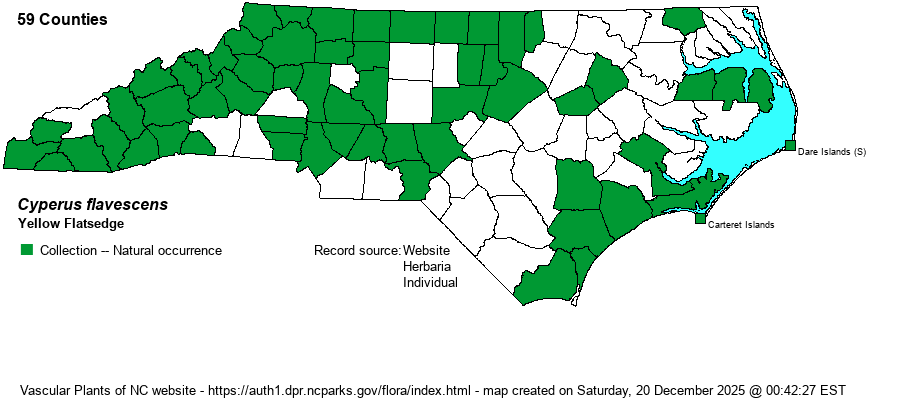| Author | L. | |
| Distribution | Primarily in the Mountains and Piedmont; outer Coastal Plain (with a broad gap in the middle and western Coastal Plain).
Pantropical, north to MA, southern Ont., MI, MO, and KS. | |
| Abundance | Frequent in the Mountains and Piedmont; uncommon in the outer Coastal Plain; rare in the western and central Coastal Plain and Sandhills. With collection records for nearly 60 counties, the species is certainly worthy of an S5 State Rank. | |
| Habitat | Moist to wet soils of marshes, margins of impoundments, river shores, ditches, disturbed areas; generally in the open. | |
| Phenology | Flowering and fruiting July-September. | |
| Identification | This species is visually quite similar to C. polystachyos, C. filicinus, and C. bipartitus, but it differs in its black mature seeds (vs. brown or gray). It is also similar to C. compressus, but the seeds are lens-shaped (lenticular) in cross-section (vs. definitely 3-angled). | |
| Taxonomic Comments | Includes var. poiformis.
The genus Cyperus is mostly tropical and warm-temperate in distribution; thus, in NC it is much commoner in the Coastal Plain than in the Mountains and Piedmont. Most species have 1-few flowering stems (culms) from grasslike basal leaves, plus a few stem leaves. At the summit is an inflorescence of very open and branched, or tightly packed, spikes, varying among species from brown to golden brown to straw-color to reddish. The arrangement of the spikelets is important, whether like a hand (digitate) or in paired or alternate rows (pinnate); as is the shape of the achene (seed), whether bi-convex in cross-section or triangular. As a group, Cyperus tends to be weedy and readily enters disturbed ground; this is true for many natives as well as all the aliens. In recent years, following DNA research, the genus has incorporated several genera that in RAB (1968) or other manuals were separate: Hemicarpha, Lipocarpha, and Kyllinga. | |
| Other Common Name(s) | None | |
| State Rank | S4 [S5] | |
| Global Rank | G5 | |
| State Status | | |
| US Status | | |
| USACE-agcp | OBL link |
| USACE-emp | OBL link |

